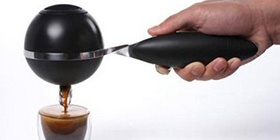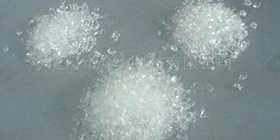We use cookies to enhance your experience. By continuing to browse this site you agree to our use of cookies. More info.
Image Credits: shutterstock.com/Vladimir Nenezic Sulfate Dioxide

There are several different types of laser systems, with carbon dioxide (CO2) lasers being one of the most popular and effective.
In CO2 lasers, beams of infrared light are produced from a gas mixture mainly composed of nitrogen, helium, and CO2. This gaseous mixture can produce excessive heat and, in order to presevre beam stability, effective cooling of the CO2 lasers is necessary to keep them operating at maximum performance.
In a laser, electrical energy is transformed into light of the same phase and wavelength. During this process, a portion of the energy is lost as heat, the build-up of which leads to a number of problems in the laser system. The quality of the laser light, specifically its wavelength purity, can be affected by variations in temperature. In cases where the temperature becomes very high, then the light-emitting components of the laser may also be damaged, which further degrades the quantity and quality of the light produced.
With lasers becoming increasingly compact and more robust, laser engineers have faced more and more difficulties in maintaining the systems temperature at operable levels. Even in applications that do not require precise control of temperature, the majority of the lasers still have to be cooled to avoid overheating of important components and to preserve the service life of the laser.
In the case of high-power lasers, a very efficient way of maintaining operating temperatures for laser systems is to use a recirculating water chiller. Analogous to an air conditioning unit, the chiller delivers coolant (water) at a constant flow rate, temperature, and quality.
It is possible to use recirculating water chillers in combination with CO2 laser systems wherever they are employed. The chiller will be selected based on the way the laser is used.
Carbon dioxide laser systems are applied in a range of high-power industrial applications. Most often, they are used for materials processing where the can be used to cut sheets of silicon or metal wafers, or to weld such materials together.1 Another area in which lasers are specifically useful is soldering, where the laser beam can be accurately directed onto a target area without heating the surrounding parts, thereby minimizing the risk of damage. Consequently, very small connectors can be laser soldered. It is also possible to use high-power lasers to treat the surface of composite, metallic, and ceramic materials to enable a coating to stick and bond to the material. In this case, applications include surface enameling and sealing of tile grouts as an innovative clean room technology. Marking and engraving can be performed with the help of lower power lasers.
These laser systems are also widely used in medical applications since water—which is a major constituent of biological tissue—effectively absorbs the infrared radiation of carbon dioxide lasers. Lasers can be used in similar fashion to a surgical scalpel, cutting and removing soft tissue such as nodules on vocal cords or warts. Other applications are skin resurfacing, where “vaporizing” is performed to promote collagen formation (also called a facelift), and more recently, “welding” human tissue in the place of sutures. Lasers have specific therapeautic advantages such as less swelling after the operation, a shorter surgery time, less bleeding, and reduced risk of infection.
CO2 lasers are also specifically used in scientific applications such as in optical tweezers and for single-molecule spectroscopy.1 In optical tweezers, highly focused laser beams are used to trap and manipulate particles as tiny as a single atom. In the field of biological sciences, these instruments have been used for applying small forces and for measuring the displacement of objects with a size of 10 nm to more than 100 mm. Optical tweezers are also used for trapping small metal particles, bacteria, viruses, and even DNA strands, enabling scientists to investigate them.
Polyscience’s 6000 Series Portable Chillers ensure reliable and stable cooling for any applications in which removal of heat from a system is mandated. Their compact, portable design makes them highly versatile, meaning they can be used in a variety of laser systems.2 Most importantly, they can run at ambient temperatures as high as 35 °C.
The chiller is designed with the choice of three distinctive pumps: either a centrifugal pump, positive displacement pump, or a turbine pump. The turbine and positive displacement pumps have cooling capacities of 700–2900 W; meaning they can eliminate 700–2900 W (Joules per second) of heat from the system. The cooling capacity of the centrifugal pump is 800–2900 W.
The choice of an ideal pump for a chiller is reliant on the required coolant flow rate (measured in liters/minute) and pressure (measured in bars) of the laser system.3 This is in turn dependent on the application of the laser system.
The 6100 Series 1 HP Chiller with a Centrifugal Pump. Image credit: PolyScience
Turbine pumps offer moderate pressures and moderate flow, and are hence most suited to applications that need a higher pressure or undergo a higher system pressure drop, such as vertical pumping or long tubing runs. A rugged design renders turbine pumps highly reliable and tolerant to impurities in the fluid stream. Although bronze turbine pumps are conventionally used, stainless steel pumps are also available.
The performance characteristics of positive displacement pumps are similar to that of turbine pumps; hence, they are ideal for pumping further or higher from the application and the cooling product. They produce moderate flow at high pressure. Although brass positive displacement pumps are the standard, stainless steel positive displacement pumps are also available.
Centrifugal pumps produce higher relative flow rates at lower pressures and are ideal for applications that are located very close to the chiller or mandate lower pressure, such as glass condensers. Although centrifugal pumps are silent and need little maintenance, they are more sensitive to pressure drops.
Recirculating water chillers are an effective tool for cooling laser systems for a wide variety of applications, such as surgical and biological applications to industrial laser cutting and welding.
This information has been sourced, reviewed and adapted from materials provided by PolyScience.
For more information on this source, please visit PolyScience.
Please use one of the following formats to cite this article in your essay, paper or report:
PolyScience. (2023, August 31). Maintaining CO2 Laser Quality with Cooling Systems. AZoM. Retrieved on September 27, 2023 from https://www.azom.com/article.aspx?ArticleID=15863.
PolyScience. "Maintaining CO2 Laser Quality with Cooling Systems". AZoM. 27 September 2023. <https://www.azom.com/article.aspx?ArticleID=15863>.
PolyScience. "Maintaining CO2 Laser Quality with Cooling Systems". AZoM. https://www.azom.com/article.aspx?ArticleID=15863. (accessed September 27, 2023).
PolyScience. 2023. Maintaining CO2 Laser Quality with Cooling Systems. AZoM, viewed 27 September 2023, https://www.azom.com/article.aspx?ArticleID=15863.
Do you have a review, update or anything you would like to add to this article?
In this interview, AZoM speaks to LECO's Andrew Storey about glow discharge spectrometry and the opportunities offered by LECO's GDS950.
At the Advanced Materials Show 2023, AZoM sat down with Tom Warwick, Director and one of the two Founders of Blue Scientific, to discuss the rapid growth of the business and its ambitions for the future.
Phil Levesque & Charlie Pryor
In this interview, AZoM speaks to Instron's Phil Levesque and Charles Pryor about the importance of mechanical testing for electric vehicle batteries.
Syft Tracer Pharm11 is a bundle solution for high-throughput, 21 CFR Part 11 compliant, automated workflows in pharmaceutical and CDMO applications.
The 6800 Series Multi-Station System offers enhanced throughput with its ability to perform independent tests on up to five separate specimens.
The CT6 automated collaborative robot introduces the benefits of automation to the testing of biomedical devices and components.
The global semiconductor market has entered an exciting period. Demand for chip technology is both driving the industry as well as hindering it, with current chip shortages predicted to last for some time. Current trends will likely shape the future of the industry, which is set to continue to show
The primary distinction between graphene-based batteries and solid-state batteries lies in the composition of either electrode. Although the cathode is commonly changed, carbon allotropes can also be employed in fabricating anodes.
In recent years, the IoT is rapidly being introduced into almost all sectors, but it has particular importance in the EV industry.
AZoM.com - An AZoNetwork Site

Hydrogen Chloride Acid Owned and operated by AZoNetwork, © 2000-2023
